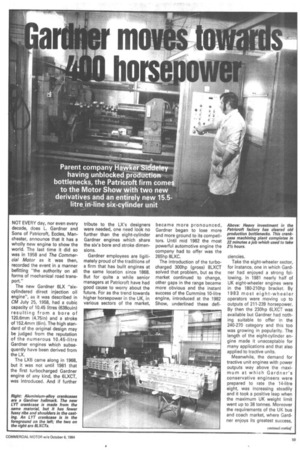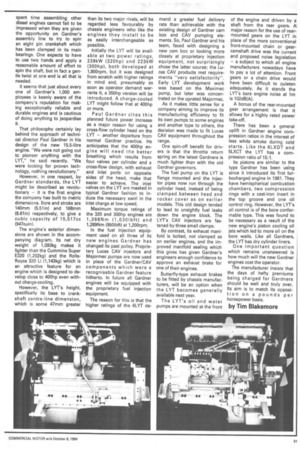NOT EVERY day, nor even every decade, does L. Gardner
Page 63

Page 64

Page 65

If you've noticed an error in this article please click here to report it so we can fix it.
and Sons of Patricroft, Eccles, Manchester, announce that it has a wholly new engine to show the world. The last time it did so was in 1958 and The Commercial Motor as it was then, recorded the event in a manner befitting "the authority on all forms of mechanical road transport."
The new Gardner 6LX "sixcylindered direct injection oil engine", as it was described in CM July 25, 1958, had a cubic capacity of 10.45 litres (638cuin) resulting from a bore of 120.6mm (4.751n) and a stroke of 152.4mm (6in). The high standard of the original design may be judged from the reputation of the numerous 10.45-litre Gardner engines which subse quently have been derived from the LX.
The LXB came along in 1968, but it was not until 1981 that the first turbocharged Gardner engine of any kind, the 6LXCT, was introduced. And if further tribute to the LX's designers were needed, one need look no further than the eight-cylinder Gardner engines which share the six's bore and stroke dimensions.
Gardner employees are ligitimately proud of the traditions of a firm that has built engines at the same location since 1868. But for quite a while senior managers at Patricroft have had good cause to worry about the future. For as the trend towards higher horsepower in the UK, in various sectors of the market, became more pronounced, Gardner began to lose more and more ground to its competitors. Until mid 1982 the most powerful automotive engine the company had to offer was the 265hp 8LXC.
The introduction of the turbocharged 300hp (gross) 8LXCT solved that problem, but as the market continued to change, other gaps in the range became more obvious and the instant success of the Cummins 10-litre engine, introduced at the 1982 Show, underlined these defi ciencies.
Take the eight-wheeler sector, for instance, one in which Gardner had enjoyed a strong following. In 1981 nearly half of UK eight-wheeler engines were in the 180-210hp bracket. By 1983 most eight-wheeler operators were moving up to outputs of 211-239 horsepower. By then the 230hp 6LXCT was available but Gardner had nothing suitable to offer in the 240-270 category and this too was growing in popularity. The length of the eight-cylinder engine made it unacceptable for many applications and that also applied to tractive units.
Meanwhile, the demand for tractive unit engines with power outputs way above the maximum at which Gardner's conservative engineers were prepared to rate the 14-litre eight, was increasing steadily and it took a positive leap when the maximum UK weight limit went up to 38 tonnes. Moreover the requirements of the UK bus and coach market, where Gardner enjoys its greatest success, were also changing significantly — the relatively new requirement for higher power engines in the increasingly popular highspecification coaches is just one example.
Those, in summary, were the product problems that faced the Hawker Siddeley subsidiary in the early nineteen eighties. Some, such as the need for a larger capacity six-cylinder engine for ratings over 300hp, were recognised a long time ago.
Only one year after Gardner became part of the Hawker Siddeley group in 1977, development work began on the LYT. Prototypes of the LXDT were first built in 1982, while clearly the 5LXCT, a relatively straightforward derivative of the 6LXCT, required much less development time.
The fact that all three new models will go into production at about the same time, starting in January next year, is a result of their different gestation periods, though no doubt the publicity opportunity offered by this year's Show provided an incentive to have them all ready by October.
Certainly, without the considerable investment that has been made over the past four years in flexible manufacturing systems at the Patricroft fac tory it would never have been possible to efficiently manufacture so many different engines together at the same time — none of the existing LXB, LXCT or 8LXCT models is being dropped to accommodate the new ones.
A prime example of how Hawker Siddeley has swept away Gardner's old production bottlenecks lies in the new computer controlled crankcase machining transfer line. It is highly automated and has more than doubled the old production capacity to around 200 a week.
Each machining station on this line is able to "recognise" auto
matically each different type of crankcase and then select the correct tools to complete its machining process. This line alone cost around f41/2 million.
More money has been spent on the foundries (Gardner has two, one for iron and one for aluminium) and a new crankshaft machining plant which greatly speeds up the process without sacrificing anything in quality control. Anyone who has spent time assembling other diesel engines cannot fail to be impressed when they are given the opportunity on Gardner's assembly line to try to spin an eight pin crankshaft which has been clamped in its main bearings. One expects to have to use two hands and apply a reasonable amount of effort to spin the shaft, but in fact a gentle twist at one end is all that is needed.
It seems that just about every one of Gardner's 1,000 em ployees is keenly aware of the company's reputation for making exceptionally reliable and durable engines and is cautious of doing anything to jeopardise it.
That philosophy certainly lay behind the approach of techni cal director Paul Gardner in his design of the new 15.5-litre engine. "We were not going out to pioneer anything with the LYT," he said recently. "We were looking for proven technology, nothing revolutionary."
However, in one respect, by Gardner standards, the LYT might be described as revolu tionary — it is the first engine the company has built to metric dimensions. Bore and stroke are 140mm (5.51in) and 168mm (8.61in) respectively, to give a cubic capacity of 15,517cc (947cuin).
The engine's exterior dimensions are shown in the accom panying diagram. Its net dry weight of 1,093kg makes it lighter than the Cummins Super E320 (1,202kg) and the Rolls Royce 320 Li (1,143kg) which is an attractive feature for an engine which is designed to develop close to 400hp even without charge-cooling.
However, the LYT's height, specifically its base to crank shaft centre-line dimension, which is some 47mm greater than its two major rivals, will be regarded less favourably by chassis engineers who like the engines they install to be as easily interchangeable as possible.
Initially the LYT will be available at two power ratings, 239kW (320hp) and 223kW (300hp), both developed at 1,800rpm, but it was designed from scratch with higher ratings in mind and, presumably as soon as operator demand warrants it, a 350hp version will be introduced. A charge-cooled LYT might follow that at 400hp or more.
Paul Gardner cites this planned future power increase as a major reason for using a cross-flow cylinder head on the LYT — another departure from normal Gardner practice. He anticipates that the 400hp engine will need the better breathing which results from four valves per cylinder and a cross-flow design, with exhaust and inlet ports on opposite sides of the head, make that easier to achieve. The inlet valves on the LYT are masked in typical Gardner fashion to induce the necessary swirl in the inlet charge at low speed.
Maximum torque ratings of the 320 and 300hp engines are 1,3 9 8Nm (1,0 3 Olbft) and 1,289Nm (950Ibft) at 1,200rpm.
In the fuel injection equipment used on all three of its new engines Gardner has changed its past policy. Proprietary Lucas CAV injectors and Majormec pumps are now used in place of the Gardner/CAV components which were a recognisable Gardner feature hitherto. in future all Gardner engines will be equipped with the proprietary fuel injection equipment.
The reason for this is that the higher ratings of the 6LYT de
mand a greater fuel delivery rate than achievable with the existing design of Gardner cam box and CAV pumping elements. So, Paul Gardner and his team, faced with designing a new cam box or looking more closely at proprietary injection equipment, not surprisingly chose the latter course; the Lucas CAV products met requirements "very satisfactorily". Early LYT development work was based on the Maximec pump, but later was concentrated on the uprated Majormec.
As it makes little sense for a company aiming to improve its manufacturing efficiency to fit its own pumps to some engines and another type to others, the decision was made to fit Lucas CAV equipment throughout the range.
One spin-off benefit for drivers is that the throttle return spring on the latest Gardners is much lighter than with the old Gardner governors.
The fuel pump on the LYT is flange mounted and the injector pipes now run through the cylinder head, instead of being clamped between head and rocker cover as on earlier. models. This old design tended to lead to unsightly fuel leaks down the engine block. The LYT's CAV injectors are fastened by three small clamps.
By contrast, its exhaust manifold is bolted, not clamped as on earlier engines, and the improved manifold sealing which this gives has given Gardner's engineers enough confidence to approve an exhaust brake for one of their engines.
Butterfly-type exhaust brakes to be fitted by chassis manufacturers, will be an option when the LYT becomes generally available next year.
The LYT's oil and water pumps are mounted at the front of the engine and driven by a shaft from the rear gears. A major reason for the use of rearmounted gears on the LYT in place of the more conventional front-mounted chain or gearcamshaft drive was the current and proposed noise legislation — a subject to which all engine manufacturers nowadays have to pay a lot of attention. Front gears or a chain drive would have been difficult to quieten adequately. As it stands the LYT's bare engine noise at 1m is 102dB(A).
A bonus of the rear-mounted gear arrangement is that it allows for a highly rated power take-off.
There has been a general uplift in Gardner engine cornpression ratios in the interest of less white smoke during cold starts. Like the 6LXDT and 5LXCT the LYT has a compression ratio of 15:1.
Its pistons are similar to the type Gardner has been using since it introduced its first turbocharged engine in 1981. They have hemispherical combustion chambers, two compression rings with a cast-iron insert in the top groove and one oil control ring. However, the LYT's oil control is of the bore conformable type. This was found to be necessary as a result of the new engine's piston cooling oil jets which led to more oil on the bore walls. Like all Gardners, the LYT has dry cylinder liners.
One important question which remains unanswered is how much will the new Gardner engines cost the operator.
The manufacturer insists that the days of hefty premiums being charged for Gardners should be well and truly over. Its aim is to match its opposition on a pounds per horsepower basis.




























































































































































